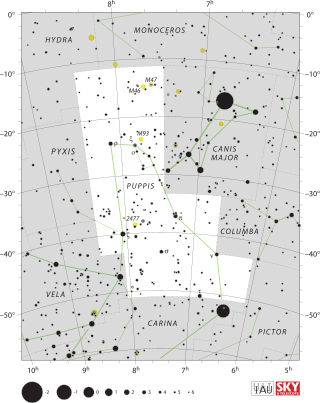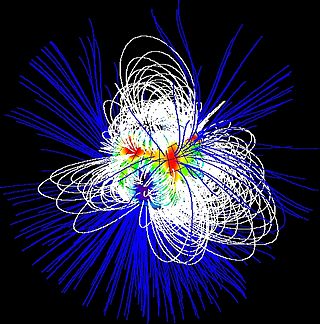Flexible Image Transport System (FITS) is an open standard defining a digital file format useful for storage, transmission and processing of data: formatted as multi-dimensional arrays, or tables. FITS is the most commonly used digital file format in astronomy. The FITS standard was designed specifically for astronomical data, and includes provisions such as describing photometric and spatial calibration information, together with image origin metadata.

Winnecke 4 is an optical double star consisting of two unrelated stars in a northerly zone of the sky, Ursa Major.
Phi Serpentis is a solitary star in the Serpens Caput portion of the equatorial constellation Serpens. Based upon an annual parallax shift of 13.52 mas as seen from Earth, it is located about 241 light years distant. The star is faintly visible to the naked eye with an apparent visual magnitude of +5.55.
107 Aquarii is a double star in the equatorial constellation of Aquarius. 107 Aquarii is the Flamsteed designation, although it also bears the Bayer designation i2 Aquarii. The pair have an angular separation of 6.787 arcseconds. They have a combined apparent visual magnitude of +5.305, with individual magnitudes of 5.72 and 6.72. The annual parallax shift measured for the two components is 16.1 mas and 20.0 mas respectively, although with significant statistical margins of error and flags for potential unreliability of both values. This indicates the system may be at a distance of 160–200 light-years from Earth.
HD 14412 is a single star in the southern constellation of Fornax. It has the Gould designation 22 G. Fornacis, while HD 14412 is the Henry Draper Catalogue designation. The star has an apparent visual magnitude of 6.33, which, according to the Bortle scale, can be dimly seen with the naked eye from rural locations. Based upon an annual parallax shift of 77.9″, this system is 42 light-years distant from the Sun. It is drifting further away with a radial velocity of +7.5 km/s.

Tau Puppis, Latinized from τ Puppis, is a star in the southern constellation of Puppis, near the southern constellation boundary with Carina. It is visible to the naked with an apparent visual magnitude of +2.95 and is located at a distance of about 182 light-years from Earth. The variable radial velocity of this system was detected by H. D. Curtis and H. K. Palmer in 1908, based on observations made at the D. O. Mills Observatory. It is a spectroscopic binary star system, with the presence of the secondary component being revealed by the shifts of absorption lines in the spectrum resulting from the Doppler effect. The two components orbit each other with a period of 1,066.0 days and a low eccentricity of 0.090.

In astrophysics, Zeeman–Doppler imaging is a tomographic technique dedicated to the cartography of stellar magnetic fields, as well as surface brightness or spots and temperature distributions.

LN Andromedae, also known as HD 217811, HR 8768, is a formerly suspected variable star in the constellation Andromeda. Located approximately 458 parsecs (1,490 ly) away from Earth, it shines with an apparent visual magnitude 6.41, thus it can be seen by the naked eye under very favourable conditions. Its spectral classification is B2V, meaning that it's a hot main sequence star, emitting light approximately with a blackbody spectrum at an effective temperature of 18,090 K.
HD 181720 is star with an orbiting substellar companion in the southern constellation of Sagittarius. It is located at a distance of 196 light years from the Sun based on parallax measurements, but is drifting closer with a radial velocity of −45.4 km/s. The star has an absolute magnitude of 4.10, but at that distance it has an apparent visual magnitude of 7.84, which is too faint to be seen with the naked eye. It shows a high proper motion, traversing the celestial sphere at an angular rate of 0.444 arcsec yr−1.
HD 86226 is a star with a pair of orbiting exoplanet companions, found in the constellation of Hydra. With an apparent visual magnitude of 7.93, it is too dim to be visible with the naked eye. The distance to this system has been determined by the parallax method, yielding a range of 149 light years. It is receding with a heliocentric radial velocity of +19.6 km/s. A survey in 2015 has ruled out the existence of any stellar companions at projected distances above 12 astronomical units.

Gamma Reticuli is a solitary star in the southern constellation of Reticulum. With an apparent visual magnitude of 4.5, it can be faintly seen with the naked eye. Based upon an annual parallax shift of 6.95 mas, it is located roughly 469 light years from the Sun. At that distance, the visual magnitude is diminished by an extinction factor of 0.08 due to interstellar dust.

Rho Cygni, Latinized from ρ Cygni, is a yellow-hued star in the northern constellation of Cygnus. It is visible to the naked eye with an apparent magnitude of 4.02. The measured annual parallax shift is 26.39 milliarcseconds, which yields a distance estimate of 124 light years. It is moving further from the Sun with a radial velocity of +6.88. The star is a member of the thin disk population of the Milky Way galaxy.
Tau6 Eridani, Latinized from τ6 Eridani, is a single star in the equatorial constellation of Eridanus, located near the constellation border with Fornax. It has a yellow-white hue with an apparent visual magnitude of 4.22, which is bright enough to be seen with the naked eye. Based upon parallax measurements, the distance to this star is around 57.5 light years. It is drifting further away with a radial velocity of +8 km/s.
Omega Eridani is a binary star system in the constellation Eridanus. It is visible to the naked eye with an apparent visual magnitude is 4.37. The distance to this star, as determined by the parallax method, is around 235 light years.

64 Eridani is a single, yellow-white hued star in the constellation Eridanus having variable star designation S Eridani. It is faintly visible to the naked eye with an apparent visual magnitude of 4.77. The annual parallax shift is measured at 12.01 mas, which equates to a distance of about 272 light years. In addition to its proper motion, it is moving closer to the Sun with a radial velocity of around −9 km/s.
HD 100655 is a star in the zodiac constellation of Leo, located 449 light years away from the Sun. It has an apparent visual magnitude of +6.45, which makes it a challenge to see with the naked eye under ideal viewing conditions. The star is moving closer to the Earth with a heliocentric radial velocity of −5 km/s. It has one confirmed planet.
HD 83332 is a solitary, orange hued star located in the southern constellation Antlia. It has an apparent magnitude of 5.68, making it faintly visible to the naked eye if viewed under ideal conditions. The star is located 285 light years away based on its annual parallax shift, but is drifting away with a radial velocity of 30 km/s.

Astropy is a collection of software packages written in the Python programming language and designed for use in astronomy. The software is a single, free, core package for astronomical utilities due to the increasingly widespread usage of Python by astronomers, and to foster interoperability between various extant Python astronomy packages. Astropy is included in several large Python distributions; it is part of package managers for Linux and macOS, the Anaconda Python Distribution, Enthought Canopy and Ureka.
57 Persei, or m Persei, is a suspected triple star system in the northern constellation of Perseus. It is at the lower limit of visibility to the naked eye, having a combined apparent visual magnitude of 6.08. The annual parallax shift of 16.4 mas provides a distance measure of 199 light years. 57 Persei is moving closer to the Sun with a radial velocity of about −23 km/s and will make perihelion in around 2.6 million years at a distance of roughly 22 ly (6.6 pc).








